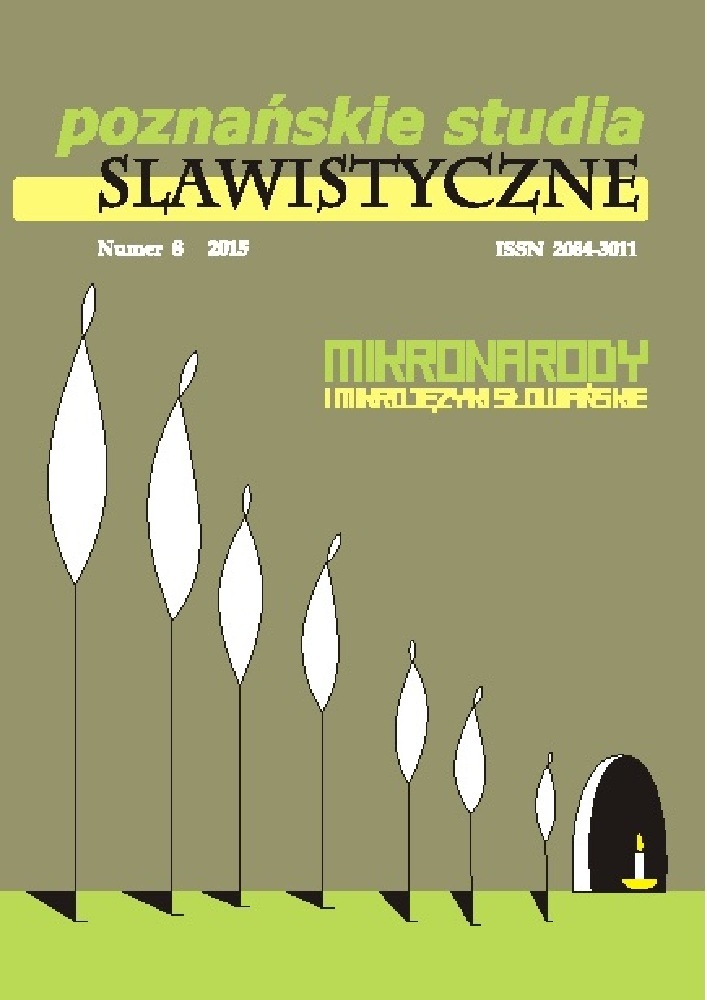Abstrakt
This article aims to present and describe the situation of the literary language of the Molise Slavs. In the last decades, various scholars have expressed their views on this issue with some of them claiming that Molise Slavic is a literary language, whilst by the other ones this vernacular was denied such right. Although Alexandr D. Dulichenko – who coined the term „Slavic literarymicrolanguage” – dated its literary traditions back to the 19th century, some scholars perceive the 18th or 20th centuries as the beginning of the literature written in Molise Slavic (MSl). Consequently, this led to ambiguity that this article is trying to clarify. Until recently, this vernacular was prevalently used for poetry and short prose, but with recent publications of Nicola Gliosca’s novels, Molise Slavic is now on its way to develop as a full-fledged literary language. According to typology presented by Antoni Furdal, MSl can now – with presence of translations – be classified as a „literary language with limited sphere of use”.
Bibliografia
Bogoczová I., 2009, Izme?u idioma, jezika i stila (uvid u jezi?nu situaciju na slavenskom, osobito ?eškom podru?ju), „Fluminensia” nr 2, http://hrcak.srce.hr/file/74612, 20.06.2013, s. 35–45.
Breu W., 2002, Moliseslawisch, w: Lexikon des osteuropäischen Sprachen, red. M. Okuka, Klagenfurt, http://www.uni-klu.ac.at/eeo/Moliseslawisch.pdf, 20.06.2013, s. 315–317.
Breu W., 2003, Das Moliseslavische, w: Einführung in die Slavischen Sprachen, red. P. Rehder, Darmstadt, s. 274–278.
Breu W., 2010, Die moliseslavische Übersetzung von Antoine de Saint Exupérys ‘Le Petit Prince’, http://www.uni-koeln.de/gbs/Berichte/Breu_Moliseslawisch.pdf, 20.06.2013.
Breu W., 2012, La ristrutturazione della categoria del genere grammaticale nello slavomolisano, w: Dialetti: per parlare e parlarne. Atti del secondo Convegno Internazionale di Dialettologia, red. P. Del Puente. Progetto A.L.B.A. Potenza, Venosa, Matera 2010. Rionero in Vulture: Calice Editori 2011, s. 35–57.
Breu W., 2012, Slava molisană, w: Introducere în studiul comparativ al limbilor slave, red. S. Paliga, Bucureşti, s. 140–157.
Breu W., Piccoli G., 2000, Dizionario croato molisano di Acquaviva Collecroce. Dizionario plurilingue della lingua slava della minoranza di provenienza dalmata
di Acquaviva Collecroce in Provincia di Campobasso. Dizionario, registri, grammatica, testi, Campobasso.Brozović D., 1970, Standardni jezik, Zagreb.
Feruga K., 2008, Socjolingwistyczne uwarunkowania j?zyka moliza?skich Chorwatów, http://www.sbc.org.pl/Content/11968/doktorat2828.pdf, 7.06.2013.
Furdal A., 1990, Językoznawstwo otwarte, Wrocław.
Gajda S., 2001, System odmian i jego dynamika rozwojowa, w: Najnowsze dzieje języków słowiańskich. Język polski, red. S. Gajda, Opole, s. 207–219.
Gliosca N., 2009, Sep aš Mena, Acquaviva Collecroce.
Granic S., 2009, From the Other Side of the Ocean: Canada’s Božidar Vidov and the Molise Croats of Italy, „Migracijske i etni?ke teme” vol. 25, nr 3 http://hrcak.srce.hr/file/68608, 20.06.2013, s. 263–287.
Klemensiewicz Z., 1982, O różnych odmianach współczesnej polszczyzny, w: Z. Klemensiewicz, Składnia, stylistyka, pedagogika językowa, Warszawa, s. 357–363.
Lindstedt J., 2011, [Review of] Evangelia Adamou, Le nashta: Description d’un parler slave de Grèce en voie de disparition, „Journal of Slavic Linguistics” vol. 19, no. 2, s. 339–345.
Perinić A., 2006, Moliški Hrvati. Rekonstrukcija kreiranja i reprezentacije jednog etni-čkog identiteta, „Etnološka tribina” vol. 36, nr. 29, s. 91–106.
Sammartino A., 2012, Pet stolje?a tišine, „Rije?i” nr 3–4, http://www.mundimitar.it/fap/casopis_rijeci/Rijeci%20Pet%20stoljece%20tisine.pdf, 20.06.2013, s. 8–21.
Sujoldži? A., 2004, Vitality and Erosion of Molise Croatian Dialect, „Collegium Antropologicum” vol. 28, nr 1, http://hrcak.srce.hr/index.php?show=clanak&id_clanak_jezik=43992, 20.06.2013, s. 263–274.
Zaręba A., 1974, Próba stworzenia nowego literackiego języka słowiańskiego we Włoszech, „Studia z Filologii Polskiej i Słowiańskiej” t. XIII, s. 261–275.
Zaręba A., 1988, Literackie języki regionalne w Polsce?, „Język Polski”, t. LXVIII, nr 2–3 (68), s. 76–96.
Дуличенко А.Д., 1998, Языки малых этнических групп: статус, развитие, проблемы выживания, в: Языки малые и большие... In memoriam acad. Nikita I. Tolstoi, „Slavica Tartuensia” nr 4, Tartu, s. 26–36.
Strony internetowe:
Nicola Gliosca –Scrittore e Poeta croatomolisano, http://www.nicolagliosca.altervista.org, 7.06.2013.
Walter Breu, Konstanz. Schriftenverzeichnis, http://www.uni-konstanz.de/FuF/Philo/Sprachwiss/slavistik/breu/PubGesamt.pdf, 20.06.2013.
Licencja

Utwór dostępny jest na licencji Creative Commons Uznanie autorstwa – Bez utworów zależnych 4.0 Międzynarodowe.
